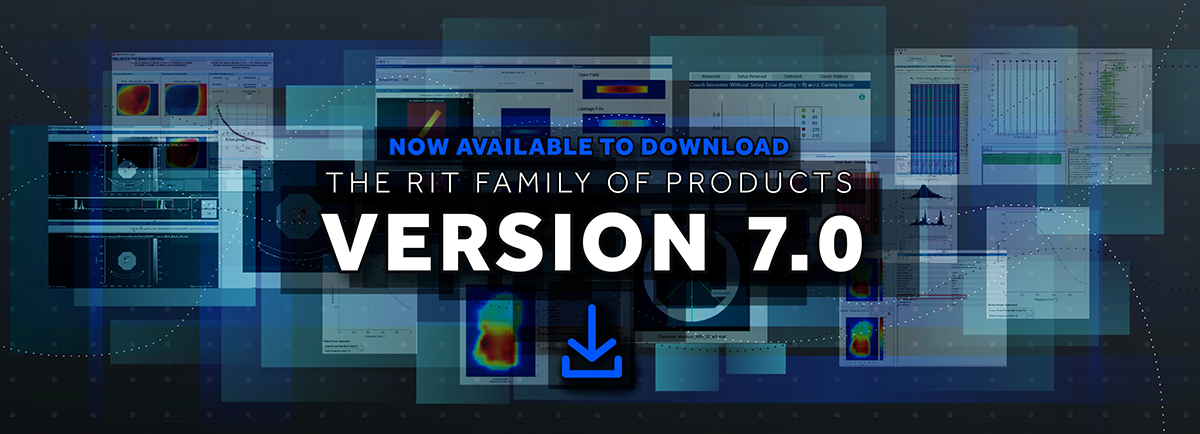Patient QA
As a leading innovator in precision automated QA, Radiological Imaging Technology® developed the first automated IMRT (Intensity-Modulated Radiation Therapy) analysis, now commonly referred to as Patient QA. RIT's Patient QA analyses provides clinical physicists with the tools necessary to analyze this advanced cancer treatment, thereby participating in the rapid availability of this treatment, both in the United States and worldwide.
General Patient QA
EPID QA: Cut Out the Middle Machine
Rotational Therapy & IMRT
- Eliminate unnecessary middle-step image capture devices
- Save $20,000 to $150,000 in purchase price alone
- Cut costs for repair, replacement, and service contracts from your budget
- Significantly improve your QA results with higher resolution and 64-bit processing
- Perform the easiest, most precise QA analysis routines available
- Speed up your QA procedures even more using RunQueueA batch analysis
General Patient QA highlights include:
- Isodose
- Distance-to-Agreement (DTA)
- Gamma Function
- Subtraction
- Centroid Measurement
The newly-added Centroid Plot compares two images and measures any shift between the centroids. This is an excellent way of quantifying any alignment or setup errors between two images. This routine is conveniently-located within the main Patient QA interface.

- Automated Image Fill for Anthropomorphic Phantom QA
Use this newly-added function in the ‘Edit’ menu to automatically correct and fill any holes or cutouts in the image file. Perform patient QA with an anthropomorphic phantom for both calibrated and uncalibrated images. This feature supports a wide variety of anthropomorphic phantoms, including those used for CyberKnife® patient QA.

PDF Export Options
Easily export the results of all patient QA measurements, including those performed in RIT's automated batch analysis feature, RunQueueA, to a customizable PDF report to display your most significant data.
TomoTherapy Registration


Easily perform exact dose comparisons for TomoTherapy® Patient QA. The new, innovative wizard uses a TomoTherapy® plan, a dose map, and a film to determine position and dose accuracy, using the red or green lasers. (NOTE: Currently, green lasers are only supported for Accuray Precision® 2.0.0.0 and above treatment planning systems.) This automated technique extends standard registration methods, as the isocenter location is not required to be in the center of the exposed dose region. Coronal or Sagittal slices may be analyzed. Utilize RIT’s patented Plan-Based Calibration technology with this routine.
The routine allows a structure to display as an overlay ROI. You can conveniently select a specific structure from any of the plan structures and display the Structure Outline on the image. Any structure in the Accuray Precision® plan may be used (e.g., PTV). Now, your analysis can be limited to the structure of your choosing, plus a user-defined margin, if preferred. You can then use RIT’s Patient QA routines to measure your results (Gamma, Subtraction, DTA, or one of 28 other analysis routines) within the ROI.
In the routine, selecting a working directory for one file (e.g., the Plan) automatically sets that path for all files in the analysis. By allowing users to keep all related files in a single directory, this feature simplifies file management by eliminating the need for repetitive path entry, thus saving time and minimizing errors.
This routine only supports the following Accuray Treatment Planning Systems:
- TomoH V 5.1.3 Build 5.1.3.9
- Precision® 1.1.0.0 Build 56037
- Precision® 1.1.1.1 Build 11
- Precision® 1.1.1.2 Build 8
- Precision® 2.0.0.0 Build 64
- Precision® 2.0.1.0 Build 14
- Precision® 2.0.1.1 Build 5
- Precision® 2.0.1.2 Build 4
- Precision® 3.0.0.0 Build 68
- Precision® 3.1.0.0 Build 42
- Precision® 3.2.0.0 Build 30
- Precision® 3.3.0.0 Build 49
- Precision® 3.3.1.0 Build 21
- Precision® 3.3.1.2 Build 5
- Precision® 3.3.1.3 Build 2
- Precision® 3.4.0.0 Build 62
- Precision® 3.4.1.0 Build 4
- Precision® 3.4.2.0 Build 15 & Build 17
- Precision® 3.5.0.0 Build 35
- Precision® 3.5.0.1 Build 3
- Precision® 3.5.0.2 Build 1
- Precision® 3.5.0.3 Build 6
- Precision® 3.5.1.0 Build 34
Plan-Based Calibration for TomoTherapy® Registration
Utilize RIT’s patented* Plan-Based Calibration technology to simplify your TomoTherapy Registration process for patient QA. With Plan-Based Calibration, a calibration file is no longer needed, the scanner warm up is minimized, and variation in development time after exposure is no longer a significant factor. This saves you time and money, and could potentially improve patient throughput. Additionally, there is no longer a need for blue or green channel corrections, eliminating a complicated and cumbersome multi-channel correction process.
Plan-Based Calibration is also a more accurate method (normalization within 1 cGy), as it is precisely tailored to each specific film, with as many data points as the user needs. It accounts for variation between film and scanners and generally increases passing capability. New guidance for tighter tolerances in TG306, TG-148’s replacement task group, raises the bar on gamma passing criteria. Plan-Based Calibration can increase the accuracy of this test, and your gammas are more likely to improve.
*Patents: EP 1683546, CA 2567197, JP 4366362, JP 4838161, US 7024026, US 7233688, US 7639851, and US 7680310.
TomoTherapy® and Precision® are registered trademarks of Accuray, Inc.

Plan-Based Calibration
RIT's patented Plan-Based Calibration routine gives you the ability to make quick relative or absolute comparisons between any dose map and your Film, EPID, CR and ion chamber array images! Using any dose map images (no special patterns needed), another image can be calibrated. Overlaying this calibration with an existing absolute calibration can give you a measurement of the overall accuracy. This technique can be used to eliminate field size dependencies in film, EPID and CR images. It can also be used with an ion chamber array to produce fast absolute dose calibration at a multitude of points.
Patents: EP 1683546, CA 2567197, JP 4366362, JP 4838161, US 7024026, US 7233688, US 7639851, and US 7680310.
RunQueueA
RunQueueA: Automated QA Checklist
 Fast, consistent batch analysis!
Fast, consistent batch analysis!
-
One Time Setup
Select from options to create an unlimited number of reusable analysis protocols, checklists and reporting scripts. -
Execute RunQueueA
Choose an unlimited number of images to create a batch and execute one of your pre-established protocols to auto-generate reports. -
DONE! Sample Time
Individually analyze each field of a 9-field IMRT Plan in 27 seconds*
*Varian aS500 EPID & Pinnacle image set
Other Modalities
3D Gels and Solids
Take advantage of a full 3D data set by using 3D Gels and Solids with the RIT Family of Products software packages. Whether you use your own 'octopus' tomographic laser scanner, or send your gel to MGS research to be scanned, you can import those files into RIT software for dose analysis. MGS claims resolutions up to 0.3 mm per slice.
CR
The RIT Family of Products fully support digital images from the Kodak / Carestream 2000RT and other CR equipment. DICOM files are easily converted to RIT format, giving you the complete palette of the RIT Family of Products routines and functionality. You get the precision of RIT dosimetry and the ease of a filmless system.
Film
Precision is the entire point of IMRT, IGRT, and VMAT. For many years, film dosimetry was the gold standard tool for the high resolution images that are the cornerstone of QA testing. Although many of our users have transitioned to using their EPID with the RIT Family of Products, film is always an option. Speed and efficiency are critical to a busy treatment center, but obtaining the most accurate dose analysis possible is the real responsibility.
2D Arrays
IMRT Analysis Routines For 2-D Arrays with the IBA MatriXX
Import from sparse arrays
- IMRT analysis routines have been revised to handle sparse data.
- Ion chamber arrays
RIT Products For Patient QA Solutions

All of RIT's therapy products in one convenient and comprehensive package.
The ideal software package for:
Medical physicists that perform various types of QA/QC measurements on a variety of machines, including both linear accelerators and imaging devices.
Quality Assurance:
Patient QA | Machine QA | MLC QA | Imaging QA

The original RIT product package that combines Machine QA (including MLC QA) and Patient QA.
The ideal software package for:
Medical physicists that require a single QA software solution for their linear accelerator(s) and for intensity-modulated radiation therapy (IMRT) procedures.
Quality Assurance:
Patient QA | Machine QA | MLC QA

RIT’s basic film analysis package for patient QA and partial machine QA measurements.
The ideal software package for:
Medical physicists that require a single software solution for film dosimetry and basic QA.
Quality Assurance:
Patient QA | Machine QA (Partial) | MLC QA (Partial)


